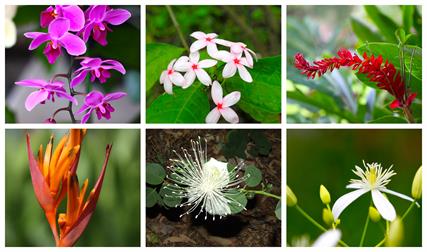
PUMPA - SMART LEARNING
எங்கள் ஆசிரியர்களுடன் 1-ஆன்-1 ஆலோசனை நேரத்தைப் பெறுங்கள். டாப்பர் ஆவதற்கு நாங்கள் பயிற்சி அளிப்போம்
Book Free DemoHave you ever looked around yourself? The world around us contains a various living organisms that differ in their structures, habit, habitat, mode of nutrition and physiology. These organisms are classified into
- Kingdom Plantae
- Kingdom Animalia
Kingdom Plantae:
Have you wondered about these different types of plants and trees? Everywhere around us, we can see a green cover of different types of plants and trees.

Some organisms of Kingdom Plantae
It is estimated that the earth contains about 8.7 million (1 million = 10 lakhs) plant species. Out of this, 8.7 million species, 6.5 million species are of terrestrial habitat, and 2.2 million species are found in aquatic habitat. Among this 4,00,000 species are flowering plants.
The kingdom plantae comprises of multicellular eukaryotic organisms. These organisms are autotrophs as they use chlorophyll for photosynthesis. However, there are very few species, which are both autotrophs and heterotrophs. Hence, all the plants are included in this kingdom.
The heterotrophs reserve food materials as starch and lipids in the form of oil or fat.
As the plants of the kingdom planate are classified based on the differentiation of their body parts
- The first level of classification depends on whether the plant body has well-differentiated, distinct parts.
- The next level classification of plants depends on the presence of special tissues in these differentiated tissues for the transport of water and other substances.
The ability to bear seeds and whether the seeds are enclosed within fruits are criteria for further classification.
Kingdom Plantae can be broadly classified into four evolutionarily related groups:
- Bryophytes (mosses)
- Pteridophytes (seedless vascular plants)
- Gymnosperms (cone-bearing seed plants)
- Angiosperms (flowering seed plants).
In the traditional system of classification, the plant kingdom is divided into two sub-kingdoms based on the ability to produce seeds. They are known as
- Non-flowering plants (Cryptogams)
- Flowering plants (Phanerogams).
Cryptogams:
The plants that do not produce seeds are known as non-flowering plants (Cryptogams).
Example:
Thalophyta
Bryophyta
Pteridophyta
Phanerogams:
The plants that produce seeds are known as flowering plants (Phanerogams).
The flowering plants are classified into two types, based on their fruit bodies. They are as follows,
Example:
Gymnosperms
Angiosperms
Reference:
https://upload.wikimedia.org/wikipedia/commons/e/e0/Kingdom_Plantae_in_Thailand_Photographed_by_Peak_Hora_%2853%29.jpg
https://upload.wikimedia.org/wikipedia/commons/d/d1/Kingdom_Plantae_in_Thailand_Photographed_by_Peak_Hora_%2864%29.jpg
https://upload.wikimedia.org/wikipedia/commons/2/2b/Kingdom_Plantae_in_Thailand_Photographed_by_Peak_Hora_%2870%29.jpg
https://upload.wikimedia.org/wikipedia/commons/4/41/Kingdom_Plantae_in_Thailand_Photographed_by_Peak_Hora_%282%29.jpg
https://upload.wikimedia.org/wikipedia/commons/1/1c/Kingdom_Plantae_and_Animalia_in_Thailand_Photographed_by_Peak_Hora_4.jpg
https://www.flickr.com/photos/48991563@N06/6689690073